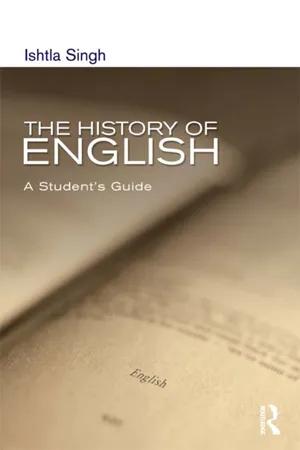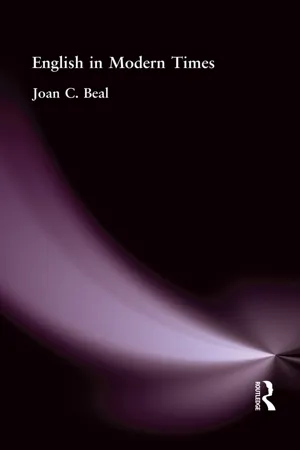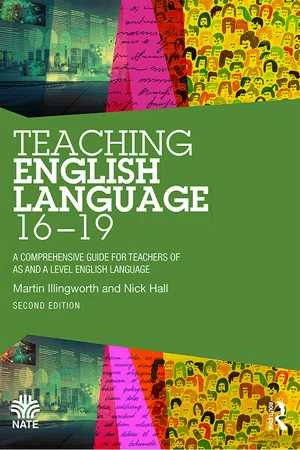Early Modern English
Early Modern English refers to the stage of the English language used from the late 15th century to the mid-17th century. It was a period of significant linguistic change, marked by the influence of the Renaissance and the rise of printing. During this time, English underwent phonological, grammatical, and vocabulary changes, leading to the emergence of many familiar features of modern English.
5 Key excerpts on "Early Modern English"
- eBook - ePub
Varieties of Modern English
An Introduction
- Diane Davies(Author)
- 2014(Publication Date)
- Routledge(Publisher)
...Chapter 3 The March of Modern English 3.1 Introduction No study of varieties of English in the modern era can afford to ignore the key events and influences in the development of the language. In this chapter we will look at the roots of ‘modern’ English, at the standardisation processes that have accompanied the language and its evolution into a ‘global’ language and international lingua franca. Modern English is most simply defined as a third stage in the history of the language, beginning around 1450 (the first two being the Old English and Middle English stages). However, this three-stage chronological model of the language is generally refined by linguists, with Modern English itself seen as divisible into distinct phases, normally called ‘Early Modern English’ (1450–1700) and ‘Modern English’ (1700 to the present day). Some linguists argue for a further stage in the language, beginning around 1945 and called ‘Late Modern English’ or ‘World English’, reflecting the globalisation of English as an international lingua franca. 3.2 Early Modern English During the Early Modern English phase a number of highly significant and liberating changes took place in English society that were to have a profound effect on the way the language was to be used and regarded. During the 16 th and 17 th centuries the concept of the autonomous nation state became a reality in Europe. In the growing market economy there was a breaking away in England from the authority of the Catholic Church through the period called the Reformation. 1 There were rapid developments in Europe in the areas of medicine, science, the arts and theology, all of which had an impact on the English language, and the beginnings of colonial exploitation of Africa, Asia and the Americas brought a further dimension of change...
- eBook - ePub
The History of English
A Student's Guide
- Ishtia Singh(Author)
- 2013(Publication Date)
- Routledge(Publisher)
...5 Early Modern English, 1500-1700 5.1 Introduction In Chapter 4 we mentioned that the Middle English period is often characterized as one of extensive social and linguistic change. As we have seen, this was undoubtedly true, but it was also a period in which many socio-political and very generally sociolinguistic ideologies and frameworks remained relatively untouched. For instance, although the fourteenth century had seen the collapse of the old feudal system and its replacement by one which carried, for certain sectors of the society, more potential for entrepreneurship and economic gain, a stratified class system remained firmly in place. Despite the upheavals and replacements at the upper echelons of the Church and State that had followed the Norman Conquest, as well as the disputes that periodically erupted between the two, these entities remained anchored in a mutually beneficial relationship that had existed for centuries. English had regained its position as an important written language, but was still secondary in status to Latin, which continued to serve as the medium of scholarship and of the all-powerful Catholic Church. Smith (1984: 16) therefore states that a contemporary ‘perceptive observer’ would very likely have assumed that the new, sixteenth century would simply see a continuation of this status quo. What Smith's observer could not have foreseen was how, within a relatively short space of time, the medieval fabric of England would begin to be ripped apart and reshaped into a more modern form. The years approximately between 1500 and 1700 (Early Modern) in particular would see significant social, political, religious and indeed linguistic change as a result of various factors; the most important of which included increasing hostility to the established church, a growing sense of national identity and advances in technology. While some of these elements were not in themselves new or unprecedented, their combined effect was dramatic...
- eBook - ePub
Linguistics for Language Teachers
Lessons for Classroom Practice
- Sunny Park-Johnson, Sarah J. Shin(Authors)
- 2020(Publication Date)
- Routledge(Publisher)
...The -s ending of such words as boy-s and girl-s is characteristic of French while the -en ending of such words as brether-en and ox-en is typical of Anglo-Saxon. But the most important grammatical development during the Middle English period was the establishment of a fixed word order. There was already a tendency toward Subject-Verb-Object (SVO) order in Old English, but this became more firmly established during the Middle English period. As mentioned earlier, Old English used inflections to signal grammatical relationships of words in a sentence. For example, the Old English noun cyning (“king”) could have different noun endings (- es, - a, - e, and - um), as in cyninges (“of the king”), cyninga (“of the kings”), cyninge (“to the king”), or cyningum (“to the kings”). But as these word endings gradually disappeared, prepositions became much more important. 9.5 Modern English (c. 1450–Present) Most linguists divide the Modern English period into Early Modern (c. 1450 to c. 1800) and Modern (c. 1800 to present). In the Early Modern period, English continues to change in significant ways, and there are many points of difference with modern usage. But by the end of the 18th century, the spelling, punctuation, and grammar are very close to what we have in English today. For instance, most people find reading a novel by Jane Austen (1775–1817) relatively straightforward. We can read for pages before encountering somewhat unfamiliar vocabulary and idiomatic expressions. But the same cannot be said about the works by William Shakespeare (1564–1616), which most certainly require us to consult a special edition or a commentary in order to understand the text. The Early Modern English period begins with the advent of printing in 1476. The invention of the printing press played a key role in the formation of a standard language, which we will discuss in further detail in Section 9.6...
- eBook - ePub
- Joan C Beal(Author)
- 2014(Publication Date)
- Routledge(Publisher)
...1 Modern English and modern times 1.1 Introduction: Defining ‘modern times’ ‘Modern times’ in this book are defined as the years from the beginning of the eighteenth century through to the end of World War II. This more or less coincides with the period generally referred to in more recent histories of English (e.g. Blake, 1996) as ‘Later Modern English’. Dates are always contentious in histories of English, and the boundaries of ‘Modern’ and ‘Later Modern’ English have long been, and are still, a matter of debate. In this chapter, I intend to demonstrate that the period covered is one in which the characteristics of both ‘Modern’ English and the modern world evolve. The term ‘Modern English’ with reference to a historical period seems to have been coined by Sweet in a lecture delivered to the Philological Society in 1873 and published in the society’s Transactions for 1873–4: ‘I propose … to start with the three main divisions of Old, Middle and Modern, based mainly on the inflectional characteristics of each stage’ (1873–4: 620). Since Sweet defined ‘Modern English’ as the period of lost inflections, there would be no need in his view for any further subdivision of this period, since the only inflection lost after the seventeenth century is the second-person singular - st. Writing at the beginning of the twentieth century, Wyld proposes a modification of Sweet’s threefold division, with Early Modern English ‘from 1400 or so to the middle of the sixteenth century’ and ‘Present-day English’ from the beginning of the eighteenth century to the time of writing (1920). Wyld is fairly typical of writers from the first half of the twentieth century in viewing the period from 1700 to what for them was ‘the present’ as coherent...
- eBook - ePub
Teaching English Language 16-19
A Comprehensive Guide for Teachers of AS and A Level English Language
- Martin Illingworth, Nick Hall(Authors)
- 2018(Publication Date)
- Routledge(Publisher)
...Shakespeare made use of all the new words that abounded at this time as well as the language of the Bible and borrowings from the Latin he used at school. He also brought in regional words from his own accent, Midlands. Figure 10 Robert Cawdrey’s A Table Alphabeticall, published in 1604. This was the first dictionary. Cawdrey chose to list only those words that he deemed ‘hard usuall English wordes’. Dr Johnson’s Dictionary of 1755 has a number of very entertaining definitions within its pages. To look at a page from the dictionary can be an illuminating way of considering the various fates of words that have prospered or died out or shifted in their meanings (Figure 11). Given the quirky nature of some aspects of the dictionary, like the very personal and subjective nature of some definitions, it can also be an interesting resource in considering the development of the genre of the dictionary. Figure 11 Dr Johnson’s Dictionary (1755) Whilst the dictionaries are recognised as being in the early modern period, they are significant in ushering in one of the key themes of the modern period, that being standardisation. It is common ground that from 1500 onwards, the language suddenly took off in terms of the sheer size of the vocabulary. This led to the desire to quantify the language. Dictionaries and grammars are symptomatic of this increase in the word hoard. The Modern Period (1500 — the present) Characterising the development of the English Language through its early periods helps your students to appreciate what had happened to the language before the date of any texts that might be chosen for examination purposes. Texts are chosen exclusively from the Modern period. A timeline activity to share with your group Here is an activity that you can try that will help to highlight where understanding is clear and where any gaps exist in the knowledge of your students...




